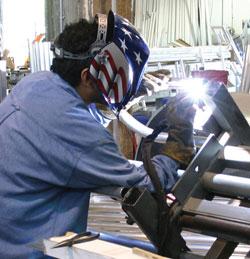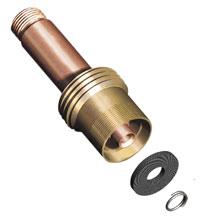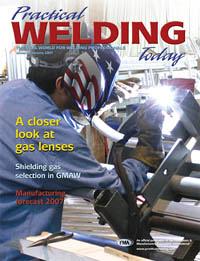Contributing Writer
- FMA
- The Fabricator
- FABTECH
- Canadian Metalworking
Categories
- Additive Manufacturing
- Aluminum Welding
- Arc Welding
- Assembly and Joining
- Automation and Robotics
- Bending and Forming
- Consumables
- Cutting and Weld Prep
- Electric Vehicles
- En Español
- Finishing
- Hydroforming
- Laser Cutting
- Laser Welding
- Machining
- Manufacturing Software
- Materials Handling
- Metals/Materials
- Oxyfuel Cutting
- Plasma Cutting
- Power Tools
- Punching and Other Holemaking
- Roll Forming
- Safety
- Sawing
- Shearing
- Shop Management
- Testing and Measuring
- Tube and Pipe Fabrication
- Tube and Pipe Production
- Waterjet Cutting
Industry Directory
Webcasts
Podcasts
FAB 40
Advertise
Subscribe
Account Login
Search
Seeing GTAW through a new lens
Gas lens basics and use
- By Mike Sammons
- January 9, 2007
- Article
- Arc Welding
Whether you're an experienced or a novice welder, you're probably familiar with the traditional components of a gas tungsten arc welding (GTAW) torch—nozzles, collets and collet bodies, back caps, and tungsten—but you may not know much about gas lenses.
Because gas lenses often are reserved for high-performance, specialty-alloy applications or low-access joints and tend to cost more than other components, not every welder uses them. However, you also can use gas lenses for general-purpose applications, in a repair or fabrication shop, and even as a home hobbyist.
As with other GTAW components, choosing the right gas lens, whether for a professional or hobby application, depends on the material to be welded, amperage requirements, joint configurations, and tungsten size. It also depends on the type of GTAW torch—air- or water-cooled—but in both cases, adding a gas lens can provide benefits in GTAW performance.
What Is a Gas Lens?
A gas lens replaces the collet body that comes standard on a GTAW torch. With a collet, the gas lens helps hold the tungsten in place and creates the electrical contact necessary for proper current transfer. It also serves a more important function: It improves shielding gas coverage and joint accessibility.
A typical gas lens is made of a copper and/or brass body with layered mesh screens of steel and stainless steel that help distribute the shielding gas evenly around the tungsten and along the weld puddle and arc. Stainless steel is used because it offers durability and rust and corrosion resistance. You can use gas lenses with all shielding gases and with both air- and water-cooled GTAW torches.
The most durable—but the more expensive—gas lenses feature an engineered porous filter media (see Figure 1) that improves laminar flow. Other gas lenses, such as those composed entirely of brass and multiple screens (see Figure 2), can serve the welding purposes of less demanding applications, but they also can be less conductive and can hinder gas flow after multiple uses.
What Does a Gas Lens Do?
Gas lenses reduce shielding gas turbulence and provide long, undisturbed laminar flow of the gas to the weld pool. Gas lenses also let you move the nozzle farther away from the joint and extend the tungsten electrode past the nozzle by 1 inch or more.1This extension helps minimize tungsten inclusions and improves visibility of the arc and the weld puddle without sacrificing shielding gas coverage, especially on joints with limited access.
Gas lenses can help when you're welding alloys that are highly reactive to atmospheric contaminants or materials used in high-temperature applications; poor gas coverage on these alloys can lead to porosity and material degradation, which may affect the weld's strength negatively. Gas coverage provided by gas lenses also helps prevent oxygen contamination and minimizes weld discontinuities on materials such as stainless steel, titanium, and aluminum. In basic GTAW applications, such as on steel, gas lenses simply improve shielding gas coverage to ensure consistent welding performance.
Thanks to the laminar flow created by the gas, gas lenses allow you to extend the electrode out farther. This additional electrode extension provides good joint and arc visibility and can improve your ability to lay a proper weld in critical applications or hard-to-reach areas, such as T, K, and Y joints.
In some applications, a gas lens can reduce shielding gas consumption, but you shouldn't use a gas lens solely for this purpose. With all things being equal—amperage, torch-to-work distance, and tungsten extension, for example—the gas lens screens provide a laminar flow that creates a wide, even gas coverage area using equal (as in a nongas lens application) or less (3 to 5 cubic feet per hour less) gas.
Gas Lens Size Selection
Gas lenses come in several sizes for air- and water-cooled torches. The type of gas lens you choose depends first and foremost on the type of front-end parts (10N or 13N) your torch requires. You also must assess the amperage requirements and tungsten size for the material being welded, along with the joint configuration and amount of joint access. For example, low-amperage applications on nonreactive materials require a different type of gas lens than high-amperage applications on specialty or reactive materials.
Gas lenses for 10N series front-end parts (common styles include 17, 18, and 26 series torches) are available in large, extra-large, and stubby types. Gas lenses for 13N front-end parts (common styles include 9 and 20 series torches) are available in standard, extra-large, and stubby types.
A standard gas lens for a torch with 13N front-end parts is sufficient for basic, low-amperage GTAW applications; a large gas lens is suitable for a torch with 10N front-end parts. Extra-large gas lenses for both 13N and 10N front-end parts can provide improved gas coverage on specialty metals and materials that tend to react to atmospheric contaminants. These larger gas lenses also can improve gas coverage on complex and hard-to-reach joints by allowing greater tungsten stick-out for more visibility of the weld puddle and better joint access.
Stubby gas lenses for both 13N and 10N series have the same physical orifice, screen size, and diameter as the extra-large lenses, but are noticeably shorter. The smaller torch profile and length can increase operator comfort by reducing the overall weight of the torch and typically allow better access to confined joints. You also can gain better torch balance and control if you combine a stubby gas lens with a short back cap.2
Properly Installing, Caring for, and Monitoring Gas Lenses
When assembling the front end of a GTAW torch with a gas lens instead of a collet body, the only two differences in installation are the replacement of the existing nozzle (also referred to as a cup) with a larger nozzle3and the addition of a transition insulator. The transition insulator seals the area where the nozzle screws into the gas lens and is an important element in welding success. Without an added insulator to accommodate the larger gas lens and nozzle, air can enter into the shielding gas stream and cause porosity or other weld discontinuities.
While there's no specific length of time a gas lens will last, as with any consumable, watch for signs of wear. Gas lenses can become contaminated with filler metal from spatter or weld popping, which can lead to screen degradation, along with shielding gas flow blockages that ultimately affect weld quality.
On aluminum, for instance, you may see a negative change in cleaning action on both sides of the weld bead if your gas lens has become clogged or worn. Or, weld pool characteristics may change on ferrous metals—the weld puddle may become erratic, for instance. Visually inspecting the gas lens for spatter or wear is the best defense against encountering these problems.
Adding a gas lens isn't the answer for every GTAW application, especially because it costs more than a standard collet body, but it can offer distinct benefits. When you encounter applications that require extra gas coverage or better accessibility to complicated joints, consult a welding distributor or torch parts manufacturer to determine if adding a gas lens is appropriate.
Notes:
- Specific applications may dictate that the electrode may stick out farther than 1 in. when used with a gas lens, but it's not recommended in most applications.
- A back cap is the torch piece that applies pressure to the back end of the collet and collet body/gas lens. It holds the tungsten in place and seals the torch head from the atmosphere.
- Nozzle size and length can vary with each application. Discuss the best gas lens/nozzle combination with the equipment manufacturer or your distributor.
About the Author
Mike Sammons
2741 N. Roemer Road
Appleton, WI 54911
920-882-6811
About the Publication
Related Companies
subscribe now

The Welder, formerly known as Practical Welding Today, is a showcase of the real people who make the products we use and work with every day. This magazine has served the welding community in North America well for more than 20 years.
start your free subscription- Stay connected from anywhere

Easily access valuable industry resources now with full access to the digital edition of The Fabricator.

Easily access valuable industry resources now with full access to the digital edition of The Welder.

Easily access valuable industry resources now with full access to the digital edition of The Tube and Pipe Journal.
- Podcasting
- Podcast:
- The Fabricator Podcast
- Published:
- 04/16/2024
- Running Time:
- 63:29
In this episode of The Fabricator Podcast, Caleb Chamberlain, co-founder and CEO of OSH Cut, discusses his company’s...
- Trending Articles
Sheffield Forgemasters makes global leap in welding technology

Welding student from Utah to represent the U.S. at WorldSkills 2024

Lincoln Electric announces executive appointments

Lincoln Electric acquires RedViking

Engine-driven welding machines include integrated air compressors

- Industry Events
16th Annual Safety Conference
- April 30 - May 1, 2024
- Elgin,
Pipe and Tube Conference
- May 21 - 22, 2024
- Omaha, NE
World-Class Roll Forming Workshop
- June 5 - 6, 2024
- Louisville, KY
Advanced Laser Application Workshop
- June 25 - 27, 2024
- Novi, MI





























